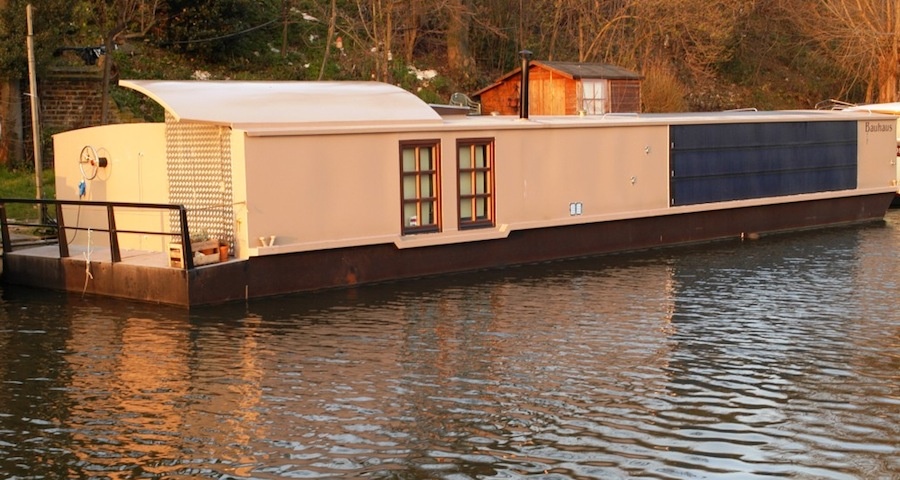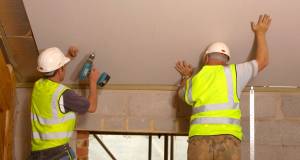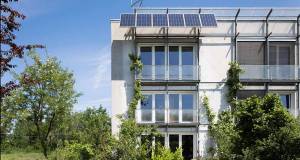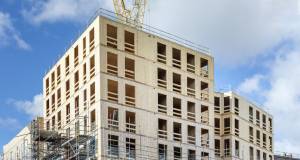
- Blogs
- Posted
The Bauhaus Barge: an energy efficient canal boat
In this in-depth post, Jurgen Huber details the story behind his energy efficient 'Bauhaus Barge'
Before building Bauhaus Barge, I lived on numerous boats and barges for over 15 years and cruised extensively on the British canal system. My wife got me into boating as she had been living on various boats for five years before we met. During our time living on the canal we bought and restored several boats and cruised the canals and rivers. The most memorable experience was cruising a narrow boat we bought in Llangollen all the way via Chester to London over many weekends, mooring here and there.
Some 10 years ago we designed our first barge, which we had built in the midlands, and with the help of a professional boat-fitter, I fitted the vessel out. Because of ongoing uncertainties concerning many aspects of our lives we very reluctantly sold the boat and moved onto dry land. However, we missed our old boat and canal life so much that in 2009 we decided to get yet another boat. Disappointed by the lack of truly innovative, ecological, economical barges and boats I put all my boating experience and a great deal of research into developing our next vessel, and the outcome was Bauhaus Barge.
I named this vessel after the amazing German arts and crafts school which was closed down by the Nazis in 1933 and, yes, after the English band Bauhaus. The boat is absolutely unique and based on the manifesto of the Bauhaus school, using basic forms to create objects which are primarily functional but also aesthetically pleasing.
The practical experience I had gained previously of altering, fitting out, and designing a boat, and the contacts I had made, helped a great deal in developing Bauhaus Barge. Furthermore, I have a ‘Meister’ in cabinetmaking and have in the past supervised the building of prefabricated passive house homes on the continent. Being involved from the early nineties with friends in the renewable energy and sustainability sectors helped a great deal in developing Bauhaus.
While the first vessel we designed was very well insulated and energy efficient, it still had a conventional diesel engine and no solar or wind power. While researching electric propulsion for barges I came across the Lynch motor and was surprised that only a few boats had been fitted with this engine. Then in 2009 I heard that a very big electric barge had just been fitted with a couple of these motors and the skipper (a friend) gave me some very encouraging feedback. At the same time PV solar systems, with all associated technologies, came down in price tremendously so incorporating such features into a boat was now an option.
Living on land I started planning for a different type of boat incorporating all my experience and these latest developments. The cost of all the various technologies used on Bauhaus was still very high so to save money in the build and fit-out the design for the shell was kept very simple, and the shell for Bauhaus was built by the same firm as our first barge. Various specialist firms carried out the installation of the Lynch motor, battery bank, solar photovoltaic system and the fit out with my help and advice.
Bauhaus takes advantage of the surrounding water and uses the energy stored in the water to heat or cool the barge. The layered composite insulation has an air gap all around between the outer and inner layers of insulation. In hot weather the air rises along the south facing side, passing under the roof, and falls on the shaded side to the bilge, which is the coldest area as it is cooled by the surrounding water.
In harsh winters, even with frozen water, the water below the ice is warmer than the air above. The warmer water below the ice generates warm air within the bilge, helping to keep Bauhaus frost free even in the coldest periods. This also helps to keep condensation to an absolute minimum. Because the boat is an all steel structure the composite insulation is totally air and water tight, and ventilation for the cabin is isolated from the insulation.
The steel on the sides and roof is insulated with polyurethane spray foam to a thickness of between 2-3 cm to stop condensation and provide basic insulation. There is also a layer of Airtec double foil insulation, but importantly between the spray foam and the Airtec is an air gap of 5-12cm.
The next layer of insulation is 5cm thick slabs of Rockwool placed between the 5 by 7.5cm tanalised pine battening, followed by 2.5cm Xtratherm polyboard. The use of polyurethane foam may not seem very green but there were not many alternatives due to cost and space.
The insulation already takes up to 16 cm measured from the outside hull; this is one foot of width which is a great deal on a four metre wide craft. To finish off 12.5mm plasterboard was applied on top of the Xtratherm. The use of plasterboard may seem quite unorthodox but makes perfect sense for an inland waterway vessel. Plasterboard is not flammable, is easy to use, is cheap, maintains a good room climate, insulates very well against air-bound noise and shields well against radiation. Sellafield, here I come!
The plasterboard is screwed onto the battens with trumpet headed screws, moisture proofed and sealed using specially formulated plasterboard primer, and fibreglass wallpaper is glued onto it and painted. If you hit an obstacle these boards will not fly off the wall or turn to dust and if you leave the window open by mistake and they get wet they will not disintegrate.
The ceiling is finished with 11mm thick OSB boards to give Bauhaus a more industrious look and to allow easy access to wiring etc. The floor is also different as there is no spray foam, just an air gap to the Airtec foil, followed by 5cm Rockwool, 18mm WPS plywood, 6mm XPT foam, electric underfloor heating and 7mm oak effect laminate flooring.
The windows are specially made in Germany and are the most energy efficient safety widows in their price range, a combination of toughened and laminated double glazing with a U-value of 1.0. The sky light has an additional 4mm polycarbonate sheet on the outside and the glazed door has an additional aluminium shutter. This means that this boat is not only exceptionally insulated but also safe.
To illustrate the effectiveness of the insulation:
In December 2010 during a cold spell we had temperatures dropping at night to -9C over several days, and during the day it was still -5C. After not being on board for days, the indoor temperature was 1C at 8am. At this point I turned all underfloor heating on and after 2.8kw/h, we had 15C throughout. After turning the heating off the temperature stayed above 10C until 10pm.
In the cold winter months we heated the barge with a wood burning 1930s Bauhaus school stove, but if a wind turbine were added to compensate for what little energy the PV system produces in the winter months, the electric underfloor heating could be used instead in a ecologically friendly manner. However, an air source heat pump would be more efficient and could be installed with little effort.
The surrounding water was also used to get more from the PV system. The water on the south facing side is used as a mirror reflecting light onto the panels which are mounted horizontally. This improves the performance of these panels tremendously because at London longitude the sun, if at all visible, is usually at quite a low angle.
During the build, encouraged by friends and fellow boaters I set up a website to provide information about the technologies, techniques and materials used. Just when Bauhaus was finished my family expanded further and Bauhaus had to be sold! I would love to see more boats using Bauhaus philosophy and technology.
I have been working now for many years in the heritage sector and I don't intend leaving, but I am hoping to develop Bauhaus Barge into a bit of a business. However, in the current financial climate and with such little public knowledge regarding renewable energy I am not overly optimistic, but I hope that over time the hostile attitude towards renewables will improve and that people realise their huge potential and enormous benefits. As part of my 9-5 job I advise on energy efficiency and sustainability so it is not surprising that I also sometimes find myself advising fellow boaters and friends. Britain has an amazing boat building tradition but has to incorporate new technology and build more economical, ecological crafts.






